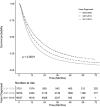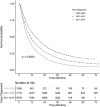Adoption of single agent anticancer therapy for advanced hepatocellular carcinoma and impact of facility type, insurance status, and income on survival: Analysis of the national cancer database 2004-2014
- PMID: 34060249
- PMCID: PMC8267126
- DOI: 10.1002/cam4.3985
Adoption of single agent anticancer therapy for advanced hepatocellular carcinoma and impact of facility type, insurance status, and income on survival: Analysis of the national cancer database 2004-2014
Abstract
Background: This study analyzes the pattern of use of single agent anticancer therapy (SAACT) in the treatment and survival of advanced hepatocellular carcinoma (aHCC) before and after sorafenib was FDA approved in 2007.
Methods: Adult patients diagnosed with HCC and treated with only ACT from 2004 - 2014 were identified in NCDB database. Patients were analyzed during three time frames: 2004-2006 (pre-sorafenib (PS)), 2007-2010 (early sorafenib (ES)) and 2011-2014 (late sorafenib (LS)). Cox proportional hazards models and Kaplan-Meier method were used for analyses.
Results: The NCDB contained 31,107 patients with HCC diagnosed from 2004-2014 and treated with ACT alone. Patients were generally men (78.0%), >50 years of age (92.5%). A significant increase in the rate of adaption of SAACT was observed over time: 6.2% PS, 15.2% ES, and 22.2% LS (p < 0.0001). During this later period, the highest proportion of SAACT is among academic and integrated network facilities (23.3%) as compared to community facilities (17.0%, p < 0.0001). The median overall survival of patients with aHCC treated only with SAACT improved significantly over time from 8.0 months (m) (95% CI: 7.4-8.8) to 10.7 m (10.4-11.2) to 15.6 m (15.2-16.0, p < 0.001). Multivariate analysis indicates worse outcomes for patients treated at community cancer programs (HR 1.28, (5% CI: 1.23-1.32), patients without insurance (HR 1.11, 1.06-1.16) and estimated household income of <$63,000 (HR 1.09, 1.05-1.13).
Conclusion: aHCC patients treated only with ACT have experienced an overall improvement in survival, but significant differences exist between facility type, insurance status, and income.
Keywords: chemotherapy; facility type; hepatocellular carcinoma; income; insurance; survival.
© 2021 The Authors. Cancer Medicine published by John Wiley & Sons Ltd.
Conflict of interest statement
The authors have declared no conflicts of interest.
Figures




Similar articles
-
Sorafenib for the treatment of advanced hepatocellular carcinoma with extrahepatic metastasis: a prospective multicenter cohort study.Cancer Med. 2015 Dec;4(12):1836-43. doi: 10.1002/cam4.548. Epub 2015 Oct 16. Cancer Med. 2015. PMID: 26471348 Free PMC article.
-
Indicators of sorafenib efficacy in patients with advanced hepatocellular carcinoma.World J Gastroenterol. 2014 Sep 21;20(35):12581-7. doi: 10.3748/wjg.v20.i35.12581. World J Gastroenterol. 2014. PMID: 25253961 Free PMC article.
-
Survival and cost-effectiveness of sorafenib therapy in advanced hepatocellular carcinoma: An analysis of the SEER-Medicare database.Hepatology. 2017 Jan;65(1):122-133. doi: 10.1002/hep.28881. Epub 2016 Nov 25. Hepatology. 2017. PMID: 27770556
-
Effect of radiotherapy on survival in advanced hepatocellular carcinoma patients treated with sorafenib: a nationwide cancer-registry-based study.Sci Rep. 2021 Jan 15;11(1):1614. doi: 10.1038/s41598-021-81176-w. Sci Rep. 2021. PMID: 33452421 Free PMC article.
-
Clinical parameters predictive of outcomes in sorafenib-treated patients with advanced hepatocellular carcinoma.Liver Int. 2013 Jul;33(6):950-7. doi: 10.1111/liv.12168. Epub 2013 Apr 21. Liver Int. 2013. PMID: 23601249
Cited by
-
A machine learning clinic scoring system for hepatocellular carcinoma based on the Surveillance, Epidemiology, and End Results database.J Gastrointest Oncol. 2024 Jun 30;15(3):1082-1100. doi: 10.21037/jgo-24-230. Epub 2024 Jun 13. J Gastrointest Oncol. 2024. PMID: 38989413 Free PMC article.
-
The Association of Socioeconomic Factors and Well-Differentiated Thyroid Cancer.J Surg Res. 2023 Mar;283:973-981. doi: 10.1016/j.jss.2022.11.033. Epub 2022 Dec 9. J Surg Res. 2023. PMID: 36915026 Free PMC article.
References
-
- American, Cancer, Society . Global cancer facts & figures 4th edition. In. 2018.
-
- Global Burden of Disease Liver Cancer Collaboration , Akinyemiju T, Abera S, et al. The burden of primary liver cancer and underlying etiologies from to 2015 at the global, regional, and national level: results from the global burden of disease study 2015. JAMA oncology. 1990;2017(3):1683‐1691. - PMC - PubMed
Publication types
MeSH terms
Substances
Grants and funding
LinkOut - more resources
Full Text Sources
Medical

